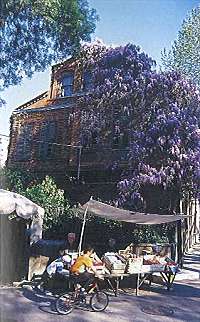In Gardens of Fleeting Love:
WISTARIA
'In early spring the gardens first turn purple. Wistaria festooned over gates, lilac reaching upwards, and purple violets a breath away from the soil. Hyacinths, primulas and dahlias. Smoke trails from ferryboats in chilly parks. Stately lilies. Purple passes first through the gardens, and only then does red become sovereign.'
 So writes Nazan Bekiroglu in her book Purple Ink. Looking about us in spring we can see that she is right. Purple does indeed first pass through the gardens of Istanbul and the islands, with wistaria, pansies, lilac, Judas blossom and purple lilies, as spring begin awakening the body and spirit with shades of purple. Spring delves deep into the earth, spurring on rebirth, and from the dark blue of the cold winter ushers in the purple and mauve transition into the red of summer. So writes Nazan Bekiroglu in her book Purple Ink. Looking about us in spring we can see that she is right. Purple does indeed first pass through the gardens of Istanbul and the islands, with wistaria, pansies, lilac, Judas blossom and purple lilies, as spring begin awakening the body and spirit with shades of purple. Spring delves deep into the earth, spurring on rebirth, and from the dark blue of the cold winter ushers in the purple and mauve transition into the red of summer.
Those who know the language of flowers can tell you that violets symbolise secret love, red roses fiery love, camellias proud love and wistaria fleeting love, although one might suppose a creeper to mean 'I cling to you, I will not leave you'. According to some the colour purple represents sorrow and pain, and they might say that even doomed love is better than no love at all. But could a lover say the same? Could the girl whom Attilâ Ilhan describes as having 'Wistaria ringlets, translucent eyelids' have said it?
Wistaria, alias Wisteria sinensis, does not like growing in pots, but needs deep soil for its long powerful roots. It loves damp climates and can grow up to 15 m in height. It came originally from China. Who knows when and moved by what fleeting passion an anonymous lover decided to take this plant with him on his long and arduous journey to Istanbul. In time the stranger became the most luxuriant flower in every quarter of Istanbul, garbing wooden houses, narrow streets and hills in a profusion of mauve and purple flowers, and scenting the air with its elusive fragrance.
On the Princes Islands and along the Bosphorus shores, in Üsküdar, Beylerbeyi, Kuzguncuk, Ortaköy and Emirgan, wistaria lends beauty even to concrete walls, compelling them to speak, as Edip Cansever writes in his spring complaints: 'Wistaria deciphered the speech / Of the ruined stone walls.' What loves have left purple traces in which memories in Istanbul's wistaria adorned streets? Perhaps in those undivided moments neither within nor entirely without time that Ahmet Hamdi Tanpinar associates with purple, someone was awaited in the windows of wistaria clad houses. In her memoirs entitled The Wistaria Clad House, Turkish novelist Halide Edip, a prominent figure of the Turkish War of Independence and a friend of Atatürk, tells us,
'For more than half a century this house has entered the dreams of a small child, sometimes every night. The windows overlooking the garden at the back and the tall narrow windows on the landings of the double staircase are festooned with wistaria and in the late afternoon sun the glass shines like a plate of fire through the purple flowers.'
The poet Can Yücel describes the melancholy that is attributed to purple:
'Wistaria / Wistaria... Purple Purple Purple / Its tears descend the wall of my life / Descend Descend.'
He is right. There are purple lives, purple novels, purple personalities. The great philosopher Nietzsche was purple, and Ahmet Haşim who was enamoured of the evening was purple. Marilyn Monroe passed through this world in a lavender shade of purple. Anna Karenina is a fictional heroin of purple. But purple is also a colour which does not only submit to loss and is not only the colour of sorrow but also of sacredness, in symbols of past and present. Purple is a symbol of empires, religions, death, attraction and passionate love that has been used by mystics, great artists and thinkers. In ancient Greece purple was the colour of wise men, and in Hindu culture it is a symbol of the sixth shakra and used to open the third eye.
In dream interpretation purple means that the dream'se troubles are at an end. In astrology purple is the colour of Sagittarius, which symbolises the half man, half horse Santor, and wistaria is one of the flowers that brings good fortune to those born under this sign. Researchers into colour today attribute the mystery of purple to its being a combination of red, which spurs people to action, and blue, which brings tranquility, thus imparting equilibrium to the human spirit.
Purple passes first through the gardens, and only then does red become sovereign. Wistaria blooms before its leaves come out, and this spring will once again adorn the city with its beautiful flowers and fill the air with its delicate scent. If the love it brings is fleeting, so be it. Let the song of wistaria fill the streets, the song of purple and mauve loves:
'Hold my hands in that wistaria garlanded street/
Caress my hair again, let me sleep on your knees.'
|